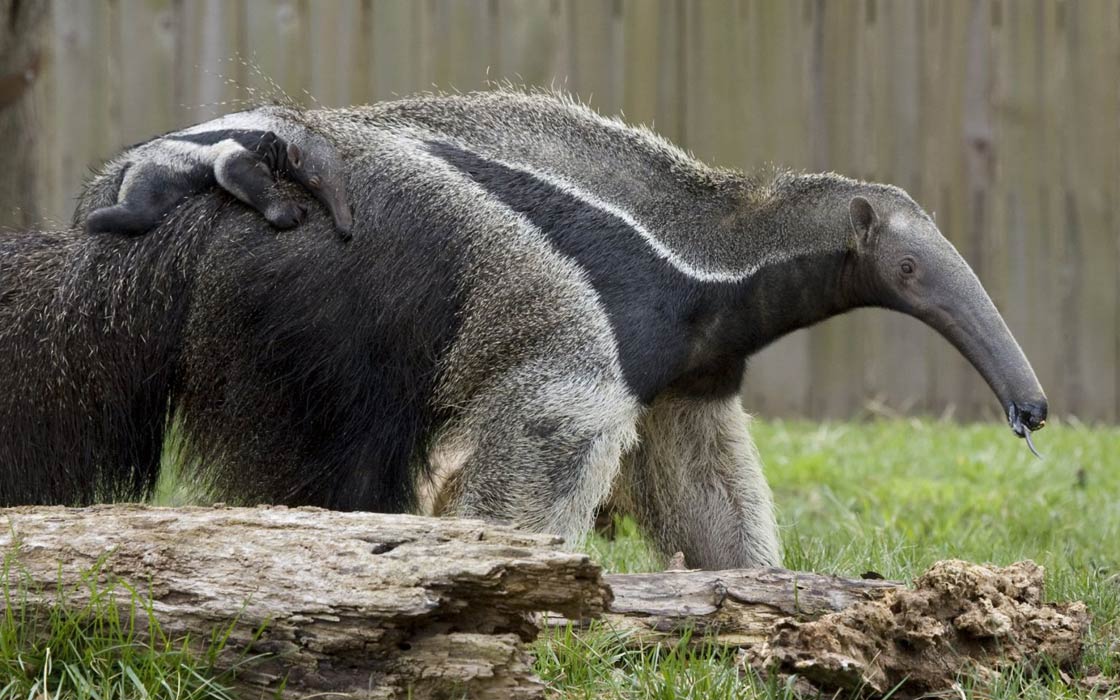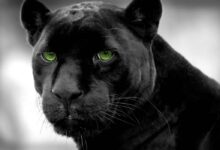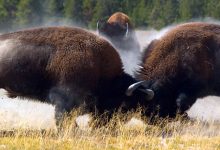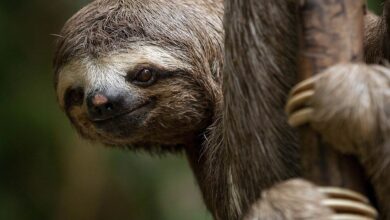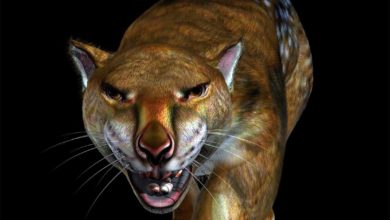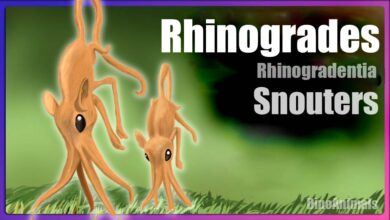The giant anteater
The giant anteater is a remarkable and unique mammal native to Central and South America. With its long snout, bushy tail, and distinctive tongue, the giant anteater stands out from any other species. It uses its long sticky tongue, which can extend up to two feet, to capture its prey, consuming up to 35,000 insects in a single day. The giant anteater also boasts powerful front claws that can measure up to 4 inches in length, providing it with the necessary defense against predators. Despite its distinctive appearance and impressive adaptations, the giant anteater is facing threats to its survival, including habitat loss and hunting, making it a conservation concern.
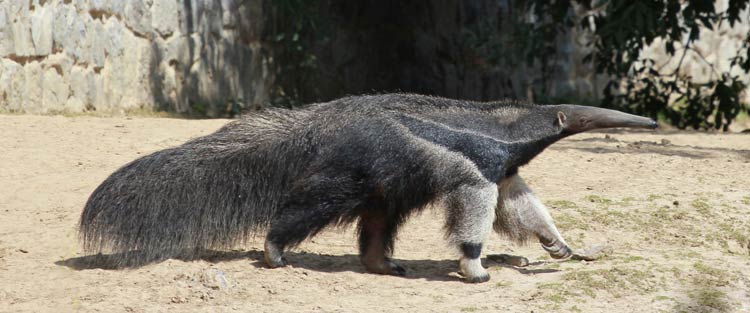
Taxonomy and phylogeny
The giant anteater (Myrmecophaga tridactyla) is a species in the order Pilosa, which also includes sloths and armadillos. It is the only species in the genus Myrmecophaga and is the largest of the four species of anteaters.
Phylogenetically, the giant anteater is closely related to the other species of anteaters, as well as sloths, and is believed to have diverged from a common ancestor approximately 60 million years ago. The Pilosa order is believed to have originated in South America and later spread to Central America. The giant anteater is found throughout much of Central and South America, from Mexico to Argentina.
Overall, the taxonomy and phylogeny of the giant anteater provide insight into its evolutionary history and place within the animal kingdom, emphasizing its unique adaptations and relationships with other species.
Scientific classification
- Kingdom: Animalia
- Phylum: Chordata
- Class: Mammalia
- Order: Pilosa
- Family: Myrmecophagidae
- Genus: Myrmecophaga
- Species: Myrmecophaga tridactyla

Basic Facts About The giant anteaters
- Habitat
The giant anteater inhabits a variety of habitats, including savannas, grasslands, and forests in Central and South America. - Diet
The giant anteater primarily feeds on ants and termites, using its long sticky tongue to capture its prey. It consumes up to 35,000 insects in a single day. - Physical characteristics
The giant anteater has a long snout, bushy tail, and distinctive tongue. Its front claws can grow up to 10 centimeters (4 inches) in length, providing it with the necessary defense against predators. The giant anteater is 182 to 217 cm (5 ft 11+1⁄2 in to 7 ft 1+1⁄2 in) in length, with weights of 33 to 50 kg (73 to 110 lb) for males and 27 to 47 kg (60 to 104 lb) for females. The head of the giant anteater, at 30 cm (12 in) long. The tongue is typically 60 cm (24 in) long. - Reproduction
Female giant anteaters give birth to a single offspring after a gestation period of six months. The young will nurse for several months and remain with their mother until reaching maturity. - Conservation status
The giant anteater is listed as a vulnerable species by the IUCN due to habitat loss and hunting. Conservation efforts are underway to protect and conserve remaining populations.
These are just some of the basic facts about the giant anteater, a remarkable and unique mammal that continues to captivate people with its distinctive appearance and impressive adaptations.
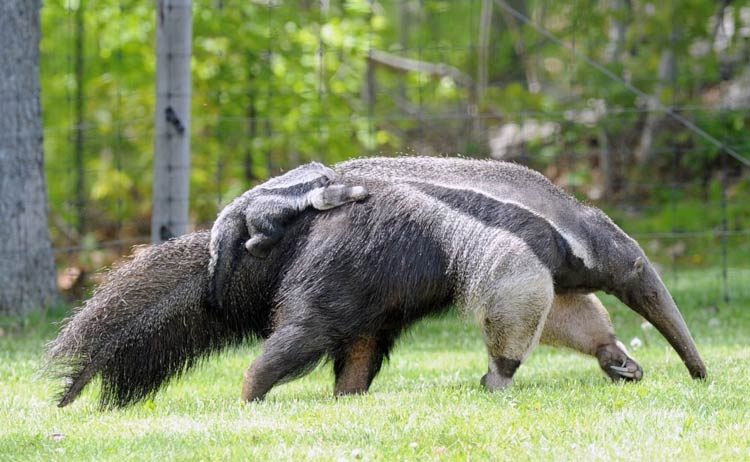
Distribution and habitat
The giant anteater is native to Central and South America, and it is found in a variety of habitats including savannas, grasslands, and forests. In Central America, it is found in Mexico, Belize, Honduras, Nicaragua, Costa Rica, and Panama. In South America, it is found in Colombia, Ecuador, Peru, Venezuela, Guyana, Suriname, French Guiana, Brazil, Paraguay, Uruguay, and Argentina.
The giant anteater requires a combination of open habitats for foraging and nearby forests or other shelters for refuge. It uses its keen sense of smell to locate ant and termite nests and feeds by using its long sticky tongue to extract the insects. It also requires access to water sources for drinking and wallows in mud to cool down and protect its skin from insect bites.
Overall, the giant anteater has a broad geographic distribution in Central and South America, but its populations are fragmented and declining due to habitat loss, hunting, and other threats. Conservation efforts are underway to protect and conserve remaining populations and their habitats.
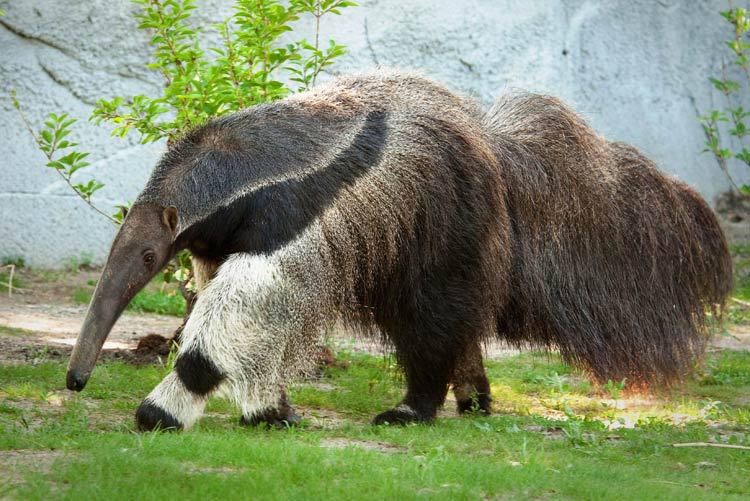
Characteristics
Appearance
The giant anteater is a distinctive and unique mammal, known for its long snout, bushy tail, and distinctive tongue. It has shaggy, grayish-brown fur and its front legs are heavily armored with long claws, up to 10 centimeters (4 inches) in length, that it uses for defense against predators.
Its body length ranges from 182 to 217 cm (6 – 7.1 ft) with a weight of 33 to 50 kg (73 to 110 lb) for males and 27 to 47 kg (60 to 104 lb) for females. Its head is 30 cm (12 in) long and its tongue is typically 60 cm (24 in) long. The giant anteater’s tongue is prehensile and covered in tiny, backward-facing spines that help it to grasp its prey, which it consumes using its molars located in the back of its mouth.
In summary, the giant anteater’s appearance is characterized by its long snout, bushy tail, and distinctive tongue, which, along with its shaggy fur, make it a unique and recognizable mammal.
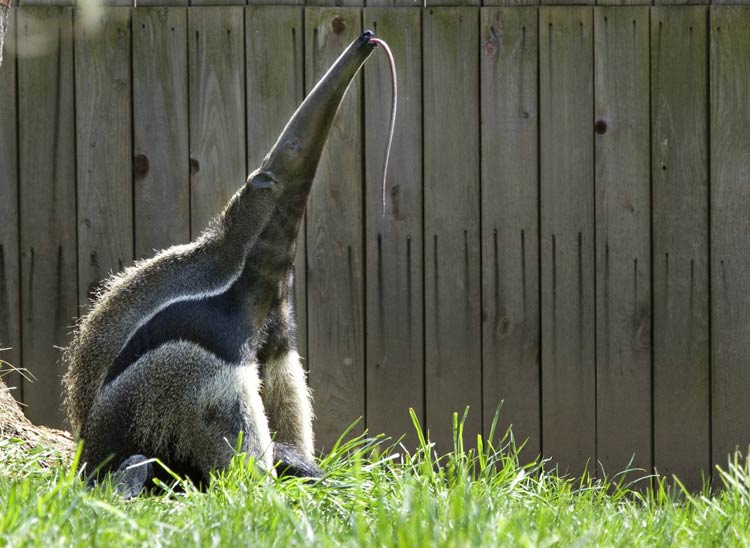
Behavior, lifestyle and ecology
The giant anteater is a solitary animal, spending most of its time alone except during mating season. It is primarily active during the day and uses its keen sense of smell to locate ant and termite nests. It feeds by using its long sticky tongue to extract the insects and can consume up to 35,000 insects in a single day.
The giant anteater is known for its slow and methodical foraging style, as it moves through its habitat using its long claws to tear open ant and termite nests. When threatened, it can use its front claws as a means of defense, and will also use its powerful front legs to deliver strong blows to any predator.
In addition to foraging for food, the giant anteater also requires access to water sources for drinking and wallows in mud to cool down and protect its skin from insect bites. Female giant anteaters give birth to a single offspring after a gestation period of six months. The young will nurse for several months and remain with their mother until reaching maturity.
The giant anteater plays an important role in its ecosystem as a consumer of ants and termites, helping to control their populations. However, its populations are declining due to habitat loss, hunting, and other threats. Conservation efforts are underway to protect and conserve remaining populations and their habitats.
In conclusion, the giant anteater is a solitary and methodical forager, known for its slow and deliberate movements and its powerful front claws, which it uses for defense and to extract its food. Despite its important role in its ecosystem, its populations are declining, making conservation efforts critical for its survival.
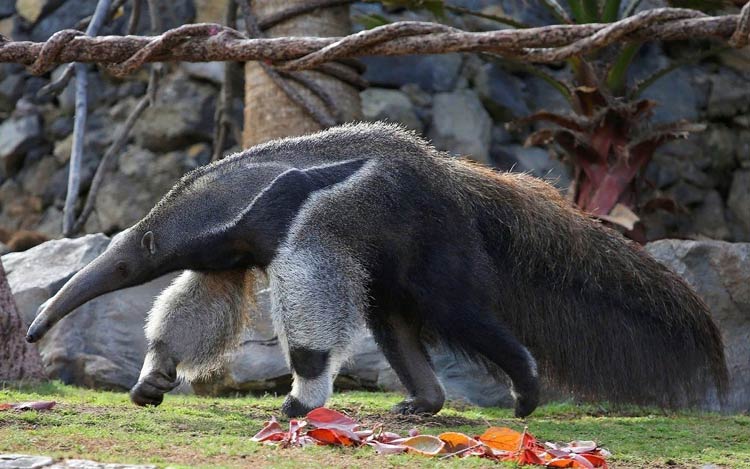
Diet
The giant anteater is an insectivore and its diet primarily consists of ants and termites. It uses its keen sense of smell to locate ant and termite nests and feeds by using its long sticky tongue to extract the insects. The giant anteater’s tongue is prehensile and covered in tiny, backward-facing spines that help it to grasp its prey. It can consume up to 35,000 insects in a single day.
The giant anteater also requires access to water sources for drinking and may consume other insects and small vertebrates, such as lizards, when available. However, its diet is predominantly made up of ants and termites and it plays an important role in controlling their populations in its ecosystem.
In summary, the giant anteater’s diet primarily consists of ants and termites, which it locates using its keen sense of smell and extracts using its long sticky tongue. Although it may consume other insects and small vertebrates, its diet is predominantly made up of ants and termites.
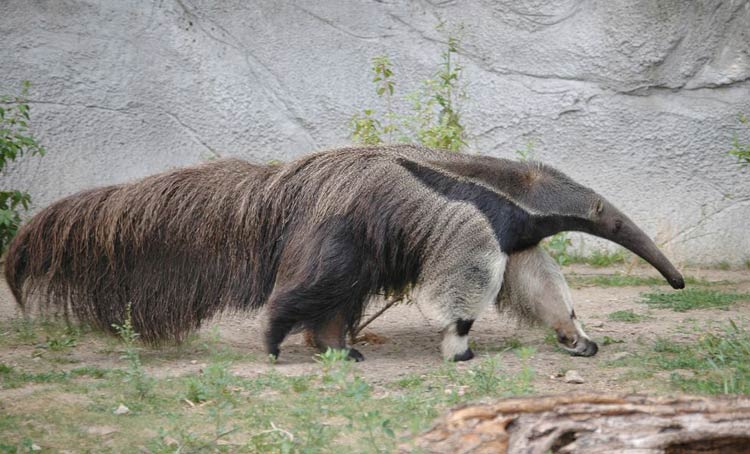
Reproduction
The giant anteater reproduces sexually, with a single offspring being born after a gestation period of six months. Female giant anteaters will nurse their young for several months and the young will remain with their mother until reaching maturity.
Mating season for the giant anteater varies depending on the location, but typically occurs between December and April. During this time, male giant anteaters will establish territories and compete for access to female mates. The female will select a mate based on the size and strength of the male, as well as his ability to provide protection and resources.
Giant anteater young are born with a full coat of fur and are able to climb onto their mother’s back within a few hours of birth. The young will nurse for several months and will remain with their mother until reaching maturity.
The giant anteater reproduces sexually, with a single offspring being born after a gestation period of six months. The young will nurse for several months and remain with their mother until reaching maturity. Mating season occurs between December and April and is characterized by territorial behavior and competition among males for access to female mates.
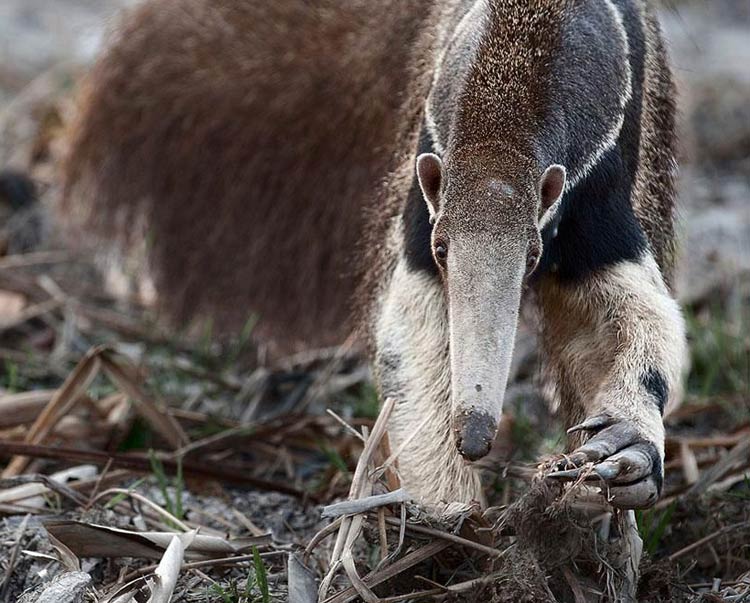
Predators and Threats
The main predators of the giant anteater are jaguars, pumas, and human hunters. These predators pose a significant threat to the giant anteater and can cause declines in populations.
In addition to predation, the giant anteater also faces several other threats, including habitat loss, fragmentation, and degradation. Deforestation and the conversion of land for agriculture and livestock farming are major drivers of habitat loss, and as a result, the giant anteater’s range and populations have declined significantly in recent years.
Hunting also poses a significant threat to the giant anteater, as its meat and pelt are valued by some local communities. In addition, the giant anteater’s long, sharp claws make it difficult to handle, which can lead to accidental injury or death during capture or captivity.
Conservation efforts are underway to protect and conserve remaining populations and their habitats. These efforts include habitat protection and restoration, anti-hunting campaigns, and captive breeding programs. In addition, the giant anteater is listed as a Vulnerable species by the International Union for Conservation of Nature (IUCN) and is protected by law in several countries.
In conclusion, the giant anteater faces several threats, including predation by jaguars, pumas, and human hunters, habitat loss, fragmentation, and degradation, and hunting. Conservation efforts are critical for the survival of this species and its populations.

Interactions with humans
The giant anteater has limited interaction with humans, but its relationship with humans is largely negative. In some areas, the giant anteater is hunted for its meat and pelt, which can result in significant declines in populations. In addition, habitat loss due to deforestation and the conversion of land for agriculture and livestock farming has also contributed to the decline of giant anteater populations.
Giant anteaters can also cause conflicts with humans in agricultural areas, where they may feed on crops and damage crops and property. In addition, their long, sharp claws make them potentially dangerous to humans, and they have been known to attack when threatened or cornered.
On the positive side, giant anteaters play an important role in controlling ant and termite populations, which can help to reduce the impacts of these insects on crops and property. In addition, the giant anteater is an important species for ecotourism in some areas and can generate income for local communities.
In conclusion, the giant anteater’s relationship with humans is largely negative, due to hunting, habitat loss, and conflicts with agricultural activities. However, it also has positive impacts as a control agent of ant and termite populations and as a potential source of income through ecotourism.
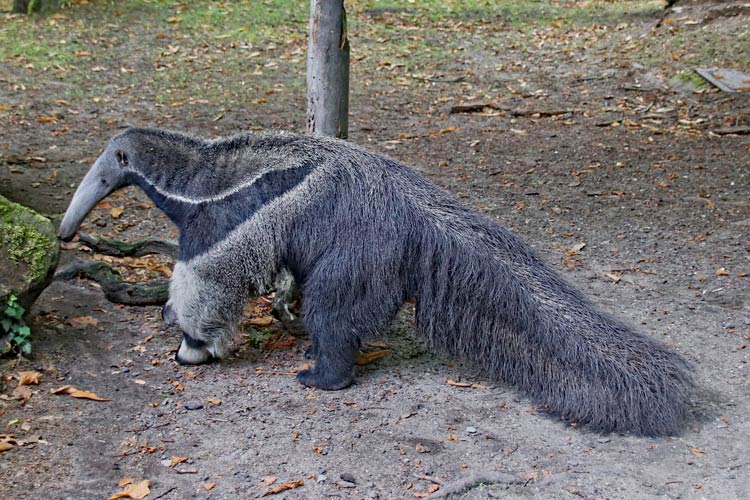
Population
The giant anteater has a fragmented and declining population, and is listed as a Vulnerable species by the International Union for Conservation of Nature (IUCN). Estimates of the global population size vary, but it is thought to be less than 10,000 individuals in the wild.
The giant anteater has a large historical range that once extended from Mexico to Argentina, but its range and populations have declined significantly in recent years due to habitat loss, fragmentation, and degradation, as well as hunting and predation by jaguars, pumas, and humans.
Today, the giant anteater is found in several protected areas, including national parks and reserves, but populations continue to decline. Conservation efforts, including habitat protection and restoration, anti-hunting campaigns, and captive breeding programs, are critical for the survival of this species and its populations.
In conclusion, the giant anteater has a fragmented and declining population, with an estimated global population size of less than 10,000 individuals. Conservation efforts are needed to protect and conserve remaining populations and their habitats.
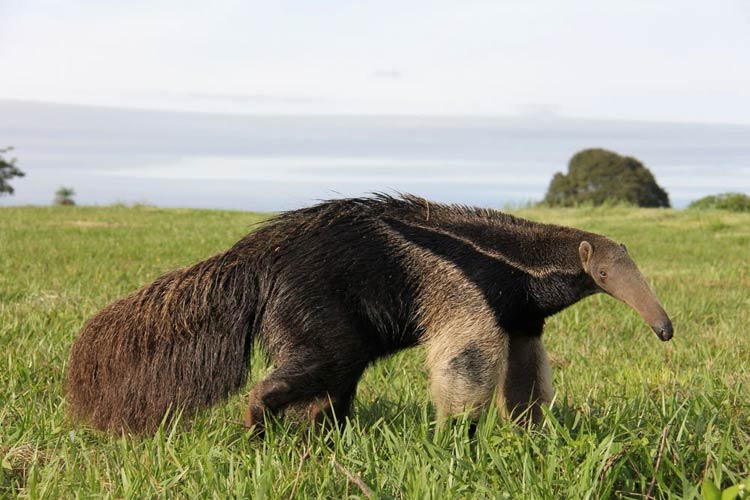
Status and conservation
The giant anteater is listed as a Vulnerable species by the International Union for Conservation of Nature (IUCN). The primary threats to the giant anteater include habitat loss, fragmentation, and degradation, as well as hunting and predation by jaguars, pumas, and humans.
Conservation efforts are underway to protect and conserve remaining populations and their habitats. These efforts include habitat protection and restoration, anti-hunting campaigns, and captive breeding programs. In addition, the giant anteater is protected by law in several countries, including Brazil, Argentina, and Mexico.
International and national conservation organizations, such as the World Wildlife Fund (WWF), are also working to conserve the giant anteater and its habitats. These organizations support habitat protection and restoration projects, as well as anti-hunting campaigns and research initiatives aimed at better understanding the species’ biology and ecology.
In conclusion, the giant anteater is a Vulnerable species and faces several threats, including habitat loss, fragmentation, and degradation, as well as hunting and predation by jaguars, pumas, and humans. Conservation efforts, including habitat protection and restoration, anti-hunting campaigns, and captive breeding programs, are critical for the survival of this species and its populations.
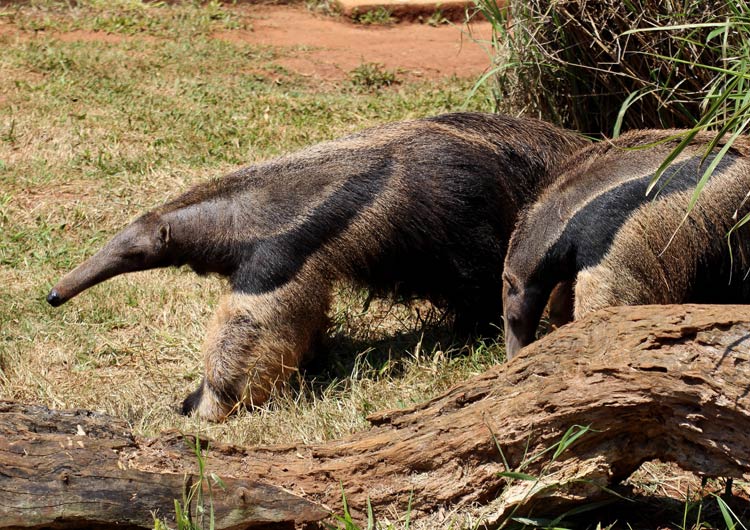
The giant anteater in numbers
- Length: 182 to 217 cm (6 – 7.1 ft)
- Weight:
- males: 33 to 50 kg (73 to 110 lb
- females: 27 to 47 kg (60 to 104 lb)
- tongue: 60 cm (24 in)
- Lifespan: up to 20 years
- Speed: 29 km/h (18 mph)

In culture
The giant anteater has been a part of human culture for centuries and has been depicted in various forms of art and folklore. Here are some examples:
- Folklore: In South American folklore, the giant anteater is often portrayed as a powerful and mysterious animal, with some indigenous communities believing that the animal has magical powers.
- Art: The giant anteater has been depicted in various forms of art, including paintings, sculptures, and tapestries. The animal’s unique appearance and solitary lifestyle have inspired many artists to create works that showcase its unique characteristics.
- Literature: The giant anteater has been featured in several books, including children’s books and nature guides. These books often emphasize the animal’s unique adaptations, such as its long tongue and sharp claws, and highlight its importance in the ecosystem.
- Zoological gardens: The giant anteater is a popular animal in zoological gardens, and many zoos have breeding programs to conserve the species. Visitors to these zoos can learn about the giant anteater’s lifestyle and adaptations, as well as its importance in the ecosystem.
- Conservation campaigns: The giant anteater has become a symbol for conservation efforts in South America, and many organizations use the image of the animal to raise awareness about habitat loss and other threats facing the species.
In conclusion, the giant anteater has played a significant role in human culture, inspiring artists, writers, and conservationists to raise awareness about the species and its importance in the ecosystem.
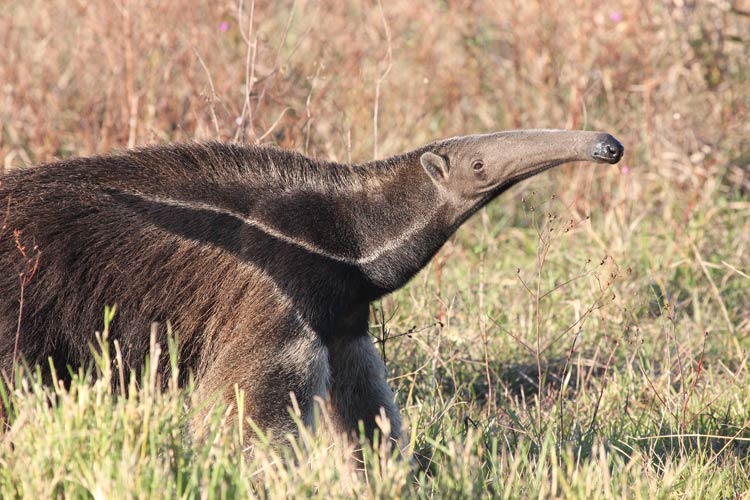
Interesting facts about the giant anteater
- Long tongue
The giant anteater has an extremely long tongue, which can reach up to 60 cm (24 in) in length. It uses its tongue to collect ants and termites from their nests, and it has up to 150,000 tiny hooks on the tongue to help it catch its prey. - Unique mouth
The giant anteater has no teeth, but instead has a muscular mouth and sharp claws, which it uses to rip open ant and termite nests to access the insects inside. - Scent marking
The giant anteater has a gland near its anus that produces a strong-smelling secretion. It uses this scent to mark its territory and communicate with other giant anteaters. - Solitary lifestyle
The giant anteater is a solitary animal and is usually only seen with other giant anteaters during the mating season. - Armadillo relatives
The giant anteater is related to armadillos, and both belong to the same order of mammals, Xenarthra. - Slow metabolism
The giant anteater has a slow metabolism, which allows it to survive on a diet that is low in calories. - Rare species
The giant anteater is a rare species, and its populations are declining due to habitat loss, hunting, and other factors.
The giant anteater is a fascinating and unique animal, with several unique adaptations and behaviors that set it apart from other species. These characteristics, combined with its rarity and declining populations, make it an important species to protect and conserve.
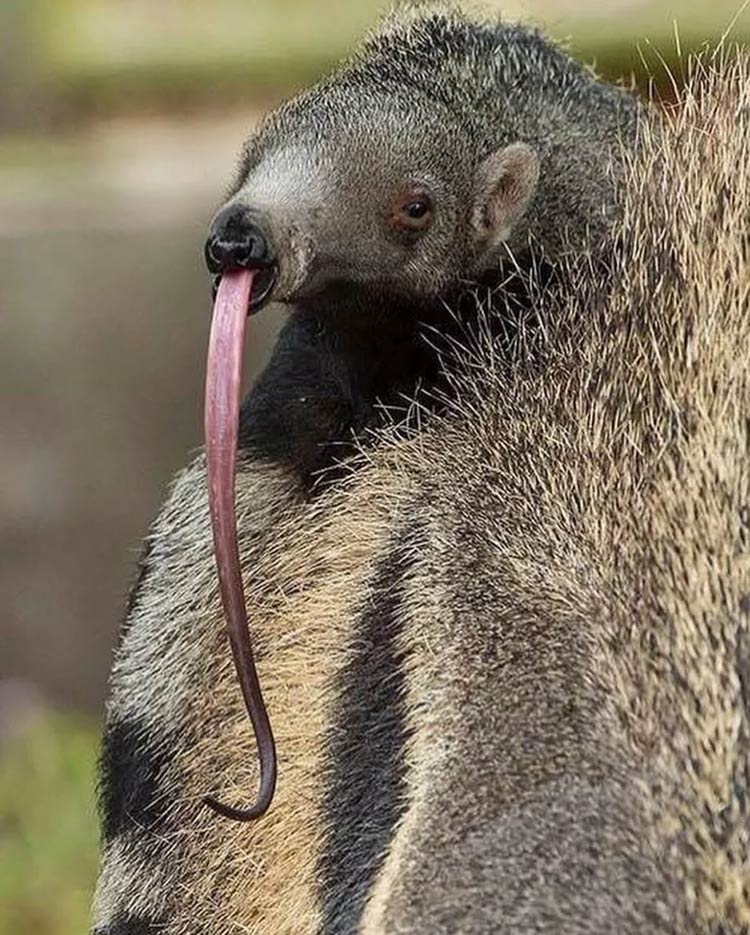
Q&A (questions and answers) about the giant anteaters
Q: What is the scientific name for the giant anteater?
A: The scientific name for the giant anteater is Myrmecophaga tridactyla.
Q: What is the length and weight of a giant anteater?
A: The length of a giant anteater is 182 to 217 cm (6 – 7.1 ft), with weights of 33 to 50 kg (73 to 110 lb) for males and 27 to 47 kg (60 to 104 lb) for females.
Q: What is the length of a giant anteater’s tongue?
A: The tongue of a giant anteater is typically 60 cm (24 in) long.
Q: Where are giant anteaters found?
A: Giant anteaters are found in Central and South America, primarily in grasslands, savannas, and forests.
Q: What does a giant anteater eat?
A: The giant anteater primarily feeds on ants and termites, and uses its long tongue to collect these insects from their nests.
Q: Is the giant anteater a social animal?
A: No, the giant anteater is a solitary animal and is usually only seen with other giant anteaters during the mating season.
Q: What are the main threats to the giant anteater?
A: The primary threats to the giant anteater include habitat loss, fragmentation, and degradation, as well as hunting and predation by jaguars, pumas, and humans.
Q: What is the conservation status of the giant anteater?
A: The giant anteater is listed as a Vulnerable species by the International Union for Conservation of Nature (IUCN).
Q: What are some efforts being made to conserve the giant anteater?
A: Conservation efforts to protect and conserve the giant anteater include habitat protection and restoration, anti-hunting campaigns, and captive breeding programs. International and national conservation organizations are also working to conserve the species and its habitats.


